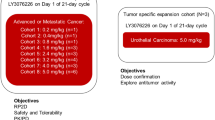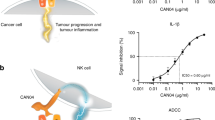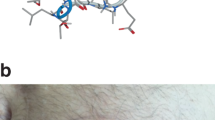Abstract
Purpose
L19-TNF is an armed antibody that selectively targets human TNF to extra domain B-fibronectin on tumour blood vessels. We performed a phase I/II first-in-man trial with L19-TNF monotherapy in metastatic solid cancer patients to study safety and signs of clinical activity.
Methods
Six cohorts of patients were treated with increasing (1.3–13 μg/kg) doses of intravenous L19-TNF on day 1, 3, and 5 of repeated 3-weekly cycles, and 12 colorectal cancer patients were treated at 13 μg/kg. PK, antibody formation, changes in lymphocyte subsets, 5-HIAA plasma levels as well as safety and clinical activity were analysed.
Results
Thirty-four patients received at least one L19-TNF dose. The serum half-life of L19-TNF at 13 μg/kg was 33.6 min, and maximum peak serum concentration was 73.14 μg/L. Mild chills, nausea and vomiting but no haemato- or unexpected toxicity were observed. Grade 3 lumbar pain in bone metastasis was the only dose-limiting toxicity found in one patient. Objective tumour responses were not detected. Transient stable disease occurred in 19 of 31 evaluable patients.
Conclusions
Intravenous L19-TNF on day 1, 3, and 5 of a 3-weekly schedule was safe up to 13 μg/kg, but did not result in objective tumour responses. The maximally tolerated dose (MTD) was not reached, allowing for further dose escalation of L19-TNF possibly in combination with chemotherapy.


Similar content being viewed by others
References
Balza E, Mortara L, Sassi F et al (2006) Targeted delivery of tumor necrosis factor-alpha to tumor vessels induces a therapeutic T cell-mediated immune response that protects the host against syngeneic tumors of different histologic origin. Clin Cancer Res 12:2575–2582
Bartsch HH, Nagel GA, Mull R et al (1988) Phase I study of recombinant human tumor necrosis factor-alpha in patients with advanced malignancies. Mol Biother 1:21–29
Bartsch HH, Pfizenmaier K, Schröder M, Nagel GA (1989) Systemic versus local therapy with recombinant tumor necrosis factor-alpha (r-TNF-alpha) in patients with advanced tumors. Onkologie 12:136–141
Blick M, Sherwin SA, Rosenblum MG, Guttermann J (1987) Phase I study of recombinant tumor necrosis factor in cancer patients. Cancer Res 47:2986–2989
Borsi L, Balza E, Carnemolla B et al (2003) Selective targeted delivery of TNF-alpha to tumor blood vessels. Blood 102:4384–4392
Brett J, Gerlach H, Nawroth P et al (1989) Tumor necrosis factor/cachectin increases permeability of endothelial cell monolayers by a mechanism involving regulatory G proteins. J Exp Med 169:1977–1991
Carswell EA, Old LJ, Kassel RL et al (1975) An endotoxin-induced serum factor that causes necrosis of tumors. Proc Natl Acad Sci USA 72:3666–3670
Chapman PB, Lester TJ, Casper ES et al (1987) Clinical pharmacology of recombinant human tumor necrosis factor in patients with advanced cancer. J Clin Oncol 5:1942–1951
Creaven PJ, Brenner DE, Cowens JW et al (1989) A phase I clinical trial of recombinant human tumor necrosis factor given daily for five days. Cancer Chemother Pharmacol 23:186–191
Curnis F, Sacchi A, Corti A (2002) Improving chemotherapeutic drug penetration in tumors by vascular targeting and barrier alteration. J Clin Invest 110:475–482
de Wilt JH, ten Hagen TL, van Tiel ST et al (2000) Tumor necrosis factor alpha increases melphalan concentration in tumour tissue after isolated limb perfusion. Br J Cancer 82:1000–1003
Del Conte G, Erba PA, Traino AC et al (2012) Dosimetry and radioimmunotherapy with 131I-L19SIP (radretumab) in solid tumors: results of a phase I trial. Eur J Nucl Med (submitted)
Erba PA, Sollini M, Orciuolo E et al (2012) Radioimmunotherapy with radretumab (131I–L19SIP) in patients with relapsed Hodgkin lymphoma and other lymphoproliferative malignancies. J Nucl Med 53:922–927
Folli S, Pelegrin A, Chalandon Y et al (1993) Tumor-necrosis factor can enhance radio-antibody uptake in human colon carcinoma xenografts by increasing vascular permeability. Int J Cancer 53:829–836
Gamm H, Lindemann A, Mertelsmann R, Herrmann F (1991) Phase I trial of recombinant human tumour necrosis factor alpha in patients with advanced malignancy. Eur J Cancer 27:856–863
Gregorc V, Santoro A, Bennicelli E et al (2009) Phase Ib study of NGR-hTNF, a selective vascular targeting agent, administered at low doses in combination with doxorubicin to patients with advanced solid tumours. Br J Cancer 101:219–224
Gregorc V, Citterio G, Vitali G et al (2010) Defining the optimal biological dose of NGR-hTNF, a selective vascular targeting agent, in advanced solid tumours. Eur J Cancer 46:198–206
Halin C, Gafner V, Villani ME et al (2003) Synergistic therapeutic effects of a tumor targeting antibody fragment, fused to interleukin 12 and to tumor necrosis factor alpha. Cancer Res 63:3202–3210
Hersh EM, Metch BS, Muggia FM et al (1991) Phase II studies of recombinant human tumor necrosis factor alpha in patients with malignant disease: a summary of the Southwest Oncology Group experience. J Immunother 10:426–430
Hoving S, Seynhaeve ALB, van Tiel ST et al (2006a) Addition of low-dose tumor necrosis factor-a to systemic treatment with STEALTH liposomal doxorubicin (Doxil) improved anti-tumor activity in osteosarcoma-bearing rats. Anticancer Drugs 16:667–674
Hoving S, Seynhaeve AL, van Tiel ST et al (2006b) Early destruction of tumor vasculature in tumor necrosis factor-alpha-based isolated limb perfusion is responsible for tumor response. Anticancer Drugs 17:949–959
Kestell P, Zhao L, Jameson MB et al (2001) Measurement of plasma 5-hydroxyindoleacetic acid as a possible clinical surrogate marker for the action of antivascular agents. Clin Chim Acta 314:159–166
Lejeune FJ, Lienard D, Matter M, Ruegg C (2006) Efficiency of recombinant human TNF in human cancer therapy. Cancer Immun 6:1–17
Lienard D, Ewalenko P, Delmotte JJ et al (1992) High-dose recombinant tumor necrosis factor alpha in combination with interferon gamma and melphalan in isolation perfusion of the limbs for melanoma and sarcoma. J Clin Oncol 10:52–60
Mavligit GM, Zukiwski AA, Charnsangavej C et al (1992) Regional biologic therapy. Heptic arterial infusion of recombinant humor tumor necrosis factor in patients with liver metastases. Cancer 69:557–561
Neri D, Bicknell R (2005) Tumour vascular targeting. Nat Rev Cancer 5:436–446
Papadia F, Basso V, Patuzzo R et al (2012) Isolated limb perfusion with the tumor-targeting human monoclonal antibody-cytokine fusion protein L19-TNF plus melphalan and mild hyperthermia in patients with locally advanced extremity melanoma. J Surg Oncol. doi:10.1002/jso.23168
Pini A, Viti F, Santucci A et al (1998) Design and use of a phage display library. J Biol Chem 273:21769–21776
Räth U, Kaufmann M, Schmid H et al (1991) Effect of intraperitoneal recombinant human tumour necrosis factor alpha on malignant ascitis. Eur J Cancer 27:121–125
Sacchi A, Gasparri A, Gallo-Stampino C et al (2006) Synergistic antitumor activity of cisplatin, paclitaxel, and gemcitabine with tumor vasculature-targeted tumor necrosis factor-alpha. Clin Cancer Res 12:175–182
Santimaria M, Moscatelli G, Viale GL et al (2003) Immunoscintigraphic detection of the ED-B domain of fibronectin, a marker of angiogenesis, in patients with cancer. Clin Cancer Res 9:571–579
Sauer S, Erba PA, Petrini M et al (2009) Expression of the oncofetal ED-B-containing fibronectin isoform in hematologic tumors enables ED-B-targeted 131I–L19SIP radioimmunotherapy in Hodgkin lymphoma patients. Blood 113:2265–2274
Schwartz JE, Scuderi P, Wiggins C et al (1989) A phase I trial of recombinant tumor necrosis factor (rTNF) administered by continuous intravenous infusion in patients with disseminated malignancy. Biotherapy 1:207–214
Spriggs DR, Sherman ML, Michie M et al (1988) Recombinant human tumor necrosis factor administered as a 24-hour intravenous infusion. A phase I and pharmacologic study. J Natl Cancer Inst 80:1039–1044
Talmadge JE, Tribble HR, Pennington RW et al (1987) Immunomodulatory and immunotherapeutic properties of recombinant γ-interferon and recombinant tumor necrosis factor in mice. Cancer Res 47:2563–2570
Therasse P, Arbuck SG, Eisenhauer EA et al (2000) New guidelines to evaluate the response to treatment in solid tumors. J Natl Cancer Inst 92:205–216
Acknowledgments
We are grateful to Dana Rogler and Fabio Vecchio for their excellent support in monitoring the study and data management, to Giulia Zigon for the excellent statistical analyses, and to Veronica Brunelli and Fabiana Marcucci, who as study nurses empathically took care of our study patients, as well as to our patients for participating in this trial. Finally, we are indebted to Dr. Azzurra Onofri, Ancona, for his valuable contributions to the trial as sub-investigator.
Conflict of interest
This study was sponsored by Philogen S.p.A, Siena, Italy, EU. Gianluca Spitaleri, Rossana Berardi, Chiara Pierantoni, Tommaso De Pas and Cristina Noberasco declare no conflicting financial interests. Filippo de Braud served as a Medical Advisor for Philogen. Chiara Libbra, Reinerio González-Iglesias, Leonardo Giovannoni, Annaelisa Tasciotti and Hans D. Menssen are employees of Philogen. Daio Neri is a co-founder and owns stocks of Philogen.
Author information
Authors and Affiliations
Corresponding author
Additional information
H. D. Menssen and F. de Braud contributed equally to this work.
Electronic supplementary material
Below is the link to the electronic supplementary material.
Rights and permissions
About this article
Cite this article
Spitaleri, G., Berardi, R., Pierantoni, C. et al. Phase I/II study of the tumour-targeting human monoclonal antibody–cytokine fusion protein L19-TNF in patients with advanced solid tumours. J Cancer Res Clin Oncol 139, 447–455 (2013). https://doi.org/10.1007/s00432-012-1327-7
Received:
Accepted:
Published:
Issue Date:
DOI: https://doi.org/10.1007/s00432-012-1327-7




